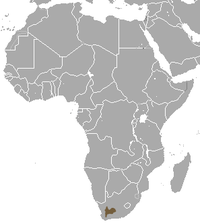Bushman rabbit
| Bushman rabbit | ||||||||||||
|---|---|---|---|---|---|---|---|---|---|---|---|---|

Bushman hare ( Bunolagus monticularis ) |
||||||||||||
| Systematics | ||||||||||||
|
||||||||||||
| Scientific name of the genus | ||||||||||||
| Bunolagus | ||||||||||||
| Thomas , 1929 | ||||||||||||
| Scientific name of the species | ||||||||||||
| Bunolagus monticularis | ||||||||||||
| ( Thomas , 1903) |
The Bushman hare ( Bunolagus monticularis ) is a species of mammal from the family of the hares (Leporidae) native to South Africa . It is considered to be one of the rarest and most threatened mammal species.
features
The thick, silky fur of the Bushman hare is grayish on the upper side, the flanks are reddish and the belly is white. This species also has a striking red patch on the neck. Its ears are very long, the bushy tail is brownish in color. The animals reach a head-trunk length of 34 to 47 centimeters and a weight of 1 to 1.9 kilograms.
distribution
The Bushman Hare lives exclusively in the bush- lined river banks in the Karoo Desert in western South Africa.
Way of life
It is nocturnal and spends the day in small pits in the shade of the bushes. Their territories are relatively large, that of the male covers an average of 21 hectares, that of the females around 12 hectares. Their diet consists of flowers, leaves and grasses.
The animals have a polygamous mating behavior, that is, a male reproduces with several females. Then the female digs a small earthwork that she pads with grass and fur. The single boy born after around five weeks of gestation is naked and blind at birth. There can be up to two births a year, but the reproductive rate for rabbit relationships is very low.
Systematics
|
Phylogenetic systematics of the rabbits according to Matthee et al. 2004
|
The Bushman hare is assigned to the hares (Leporidae) as an independent species and monotypical genus . No subspecies are distinguished within the species. The first scientific description of the species was in 1903 by Oldfield Thomas as Lepus monticularis , in 1903 he described the independent genus Bunolagus and classified the species as a type species and the only species.
On the basis of molecular biological data, Conrad A. Matthee et al. In 2004 a cladogram was developed which shows the phylogenetic relationships of the genera within the hares to one another. Accordingly, the Bushman hare is the sister species of the Ryukyu rabbit ( Pentalagus furnessi ), which is only found on the Ryūkyū Islands , Japan , and forms a taxon with it . This contrasts with a taxon from the wild rabbit ( Oryctolagus cuniculus ) and the bristle rabbit ( Caprolagus hispidus ), while the cottontail rabbits ( Sylvilagus ) and the dwarf rabbit ( Brachylagus idahoensis ) that live in America represent the sister group of these four species.
No subspecies are distinguished within the species. It bears the name Bushman "hare", although it has rabbit-like properties. So she lives in earthworks and the young are nestled. Probably the resemblance to the real rabbit , especially in the long ears, was the decisive factor. In English, however, it is called Riverine or Bushman Rabbit , i.e. rabbit.
Threat and protection
Bushman hares are one of the rarest mammals. First discovered in 1902, the species was sometimes thought to be lost for decades (e.g. between 1948 and 1979). The main problem is the conversion of their habitat into agricultural land, so more than 60 percent of their potential habitat has been lost in the last few decades. Their habitat is completely privately owned by farmers, and educational programs are designed to raise awareness of the threat to this species. Dog stalking and possibly hunting also play a role. More recent estimates assume no more than 250 living specimens.
supporting documents
- ^ A b Conrad A. Matthee, Bettine Jansen Van Vuuren, Diana Bell Terence J. Robinson: A Molecular Supermatrix of the Rabbits and Hares (Leporidae) Allows for the Identification of Five Intercontinental Exchanges During the Miocene. Systematic Biology 53 (3); Pp. 433-447. ( Abstract )
- ^ A b Don E. Wilson & DeeAnn M. Reeder (Eds.): Bunolagus monticularis in Mammal Species of the World. A Taxonomic and Geographic Reference (3rd ed).
literature
- Ronald M. Nowak: Walker's Mammals of the World . Johns Hopkins University Press, Baltimore 1999, ISBN 0-8018-5789-9 .
Web links
- Bunolagus monticularis in the endangered Red List species the IUCN 2006. Posted by: South African Mammal CAMP workshop, 2008. Accessed January 2 of 2009.
- Entry "Bushman Hare - South Africa's Most Endangered Mammal" at the Foundation for Species Protection
- English article on the Bushman rabbit with literature list
- Photo of a Bushman rabbit
